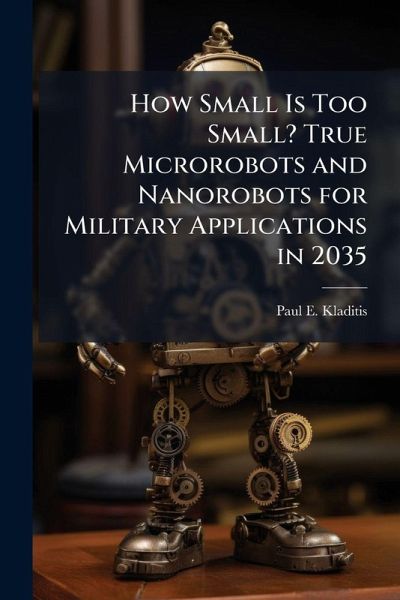
How Small Is Too Small? True Microrobots and Nanorobots for Military Applications in 2035

PAYBACK Punkte
8 °P sammeln!
The Department of Defense (DOD) anticipates the realization of biomimetic bird and two-inch-insect sized systems within the 2015 - 2047 time frame. Although robot systems on the order of size of one millimeter or smaller are not explicitly specified in current DOD and United States Air Force technology roadmaps, the technological aims toward this size can be clearly implied from official documents. This research assesses the likelihood of, and barriers to, the realization of true microrobots and nanorobots (defined as sub-millimeter sized robots of micrometer and nanometer proportions, respect...
The Department of Defense (DOD) anticipates the realization of biomimetic bird and two-inch-insect sized systems within the 2015 - 2047 time frame. Although robot systems on the order of size of one millimeter or smaller are not explicitly specified in current DOD and United States Air Force technology roadmaps, the technological aims toward this size can be clearly implied from official documents. This research assesses the likelihood of, and barriers to, the realization of true microrobots and nanorobots (defined as sub-millimeter sized robots of micrometer and nanometer proportions, respectively) that can perform in military applications by 2035. The findings of this research are that the realization of true microrobots for military applications by 2035 is unlikely except for a single case of microrobots. Furthermore, the realization of true nanorobots for military applications by 2035 is even more unlikely. Technological advancements accrued through striving towards the goals of true micro- and nanorobots are critical towards the U.S. achieving a technological edge in more realizable-sized miniature robots for military application. Additionally, these technological advancements are critical for reducing the size and payload of a host of other military systems including satellites, aircraft, weapons, C4ISR, and portable sensors. Thus, regardless of the feasibility of sub-millimeter sized robots by 2035, the U.S. should still sponsor research and development of both true microrobots and nanorobots today. This work has been selected by scholars as being culturally important, and is part of the knowledge base of civilization as we know it. This work was reproduced from the original artifact, and remains as true to the original work as possible. Therefore, you will see the original copyright references, library stamps (as most of these works have been housed in our most important libraries around the world), and other notations in the work. This work is in the public domain in the United States of America, and possibly other nations. Within the United States, you may freely copy and distribute this work, as no entity (individual or corporate) has a copyright on the body of the work. As a reproduction of a historical artifact, this work may contain missing or blurred pages, poor pictures, errant marks, etc. Scholars believe, and we concur, that this work is important enough to be preserved, reproduced, and made generally available to the public. We appreciate your support of the preservation process, and thank you for being an important part of keeping this knowledge alive and relevant.












